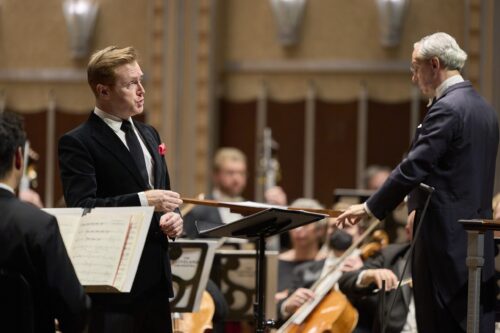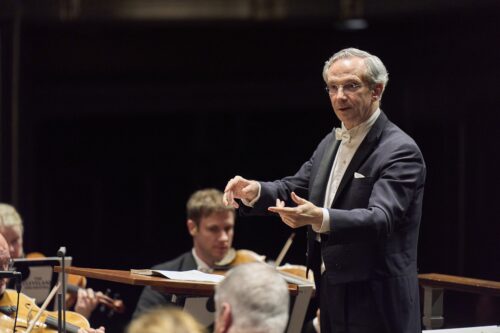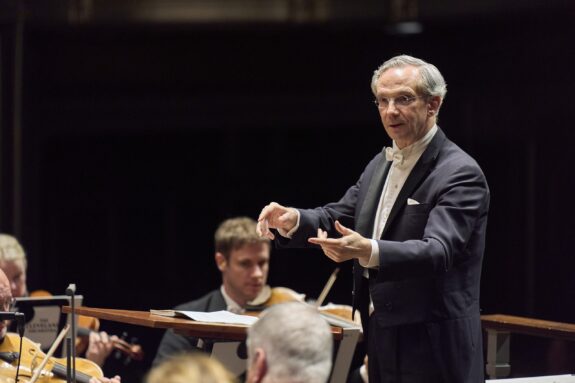 United States Colasanti, Bruckner: Tim Mead (countertenor), Cleveland Orchestra / Fabio Luisi (conductor). Mandel Concert Hall at Severance Music Center, Cleveland, 13.2.2025. (MSJ)
United States Colasanti, Bruckner: Tim Mead (countertenor), Cleveland Orchestra / Fabio Luisi (conductor). Mandel Concert Hall at Severance Music Center, Cleveland, 13.2.2025. (MSJ)

Silvia Colasanti – Time’s Cruel Hand
Bruckner – Symphony No.7 in E major (1883 version, ed. Leopold Nowak)
Fabio Luisi returned to the Cleveland Orchestra with an intriguing program that matched an old favorite with a piece that could become a new favorite. The latter was the US premiere of Italian composer Silvia Colasanti’s Time’s Cruel Hand, a song cycle from 2022 that used three Shakespeare sonnets for its text. While Colasanti was a student of the late German composer Wolfgang Rihm, one might only hear it in her skilled writing for orchestra. Unlike works by the often-astringent Rihm, Colasanti’s piece was immediately engaging and evocative, using a tonal backdrop to earn dissonances for expressive purposes.
The texts were Shakespeare Sonnets numbers 64, 19 and 60, intense ones that all ponder the attack of time on beauty, youth and happiness. The ominousness of the texts, combined with the knowledge that Colasanti was a student of Rihm, might seem to promise an aggressively modern score, but Colasanti chose instead to approach the darkness with spare, evocative, expressive orchestral writing topped with poignant vocal writing for a countertenor voice, delivered here with power and poise by Tim Mead. The writing tested Mead’s range from a tenor chest voice up to piercing high notes, and he savored the challenge with resplendent tone. The piece was received warmly, and it leaves the listener wanting to hear more of Colasanti’s work.
There are different schools of thought about Bruckner. In Cleveland, for the last couple of decades, we have had the chance to live with Franz Welser-Möst’s approach, which favors a plain-spoken, unvarnished way with the composer’s expansive symphonies. Fabio Luisi, who did Bruckner’s No.4 in Cleveland in 2017, takes a very different approach. Luisi’s is, arguably, a more mainstream style, polishing up Bruckner’s jagged edges, easing abrupt transitions with some artful tempo manipulation and ending the composer’s large orchestral chords with a suave dovetailing instead of a brusque cutoff.

Luisi’s tempos were spacious in the first two movements of the Bruckner, adjusting speed for the more rhythmically driven sections. He savored string details more than wood and brass, which became a touch buried in places, but the sumptuous sound was urbane and polished. In particular, he scaled passages with an eye to the long line, finding the shape of these vast movements. The Wagner tubas in the slow movement were gorgeously sepulchral, given more rein to sing with vibrato than Welser-Möst customarily allows. Luisi also encouraged the brass to play with laden fullness in the climax of the movement but, surprisingly, he opted to delete the cymbal crash in the printed score, which was marked ‘not valid’ in one of Bruckner’s handwritten scores (though scholars disagree about whether or not the handwriting is Bruckner’s). I like the use of the cymbal to punctuate the symphony’s highpoint, but its omission does the work no harm.
The Scherzo was thrilling, fast and deftly shaped, the Finale a little less so, with Luisi making use of the score’s tempo adjustments that many suspect were suggestions to Bruckner by the work’s first conductor, Arthur Nikisch. The Nikisch marking makes a meal out of the third theme, the stern pronouncements by the lower brass, requiring an awkward gearshift back into the quick main tempo. This is presumably why some conductors, including Welser-Möst, omit the tempo shifts. Nonetheless, this was in the context of a shapely, lyrical, polished concept of the work, and did little to detract from its effectiveness as a skillful presentation and artful alternative to the more deeply affecting directness we are used to in Cleveland.
The orchestra played with noble poise, proving again that the Cleveland is one of America’s finest Bruckner orchestras, and that it is also eminently capable of making a new work like the Colasanti sound perfectly at home. Such a skillfully presented concert keeps Luisi firmly in the running for consideration in the search for a music director to succeed the departing Welser-Möst in 2027, though his emphasis on surface polish over plain-spoken directness would certainly take the orchestra in a different direction.
Mark Sebastian Jordan
